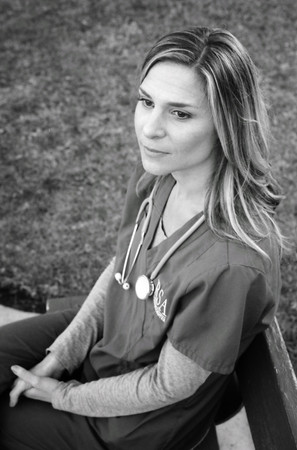You can see it in their face the moment they fall in love.
- Jen Buehler, Fertility Nurse
- Feb 5, 2019
- 14 min read
Updated: Oct 27, 2020
Jen Buehler Fertility Nurse
I did not originally want to be a nurse. My mom had suggested it to me while I was in high school, getting ready to go to college, like “You would be a great nurse.” And I was thinking, “No, all they do is wipe people’s butts and that’s it. And they clean up poop, and… no.” I had done physical therapy when I was in high school for an injury and I loved the biology and the medicine part of it but I thought, “Nurses don’t do anything that I am interested in.” I went to college and I was a bio major but I didn’t think I wanted to be a doctor, either. I specialized in physiology, which is functions of the body, and I took a reproductive biology class in college and scored the top of my class. It wasn’t just reproductive biology for humans, it was all animals, but there was something about it like, “Yes. I get this, it makes sense.”
What I thought was really interesting about it was I had girlfriends who would come to me asking me questions about their body. We’re at the end of college, we’re 21, 22 years old and they have no idea of their reproductive health, they have no idea how they can get pregnant, or how they can prevent pregnancy. I had a friend who came to me and said, “I have a really personal question… how do you put in a tampon?” And I thought, how is it that your mom, your doctor, no one has helped you with this? No support. So I took her into the bathroom and I showed her what a tampon did and kind of told her how to — I didn’t actually do it for her — but I told her how to do it… I was just absolutely amazed that she had gone this long without knowing that. I thought, you know what, if all of my friends are asking me these questions, there’s a real need for someone to talk to women about their bodies because they have no idea. I thought a nurse practitioner could probably bridge that gap and be able to be more patient-focused, so that’s when I started mulling the idea of going to nursing school.
I had no intention of being a labor and deliver nurse when I started. I went to Western University which is in Pomona and it was a master’s entry program. I hated nursing school! Because biology was so cut and dry, it was black and white, there was one answer. In nursing school, it was always like, “It depends.” What’s the situation, what other things does the patient have going on; there was always lots of grey when I wanted black and white. I was always asking, “What’s the right answer here??”
I learned all about the whole pregnancy, where things can go wrong, where things go right, and how to provide medical care for all of the different outcomes. We had many patients on our unit in all states of pregnancy, some in labor, some who were delivering, we had an operating room for C-sections, and we had a unit for antepartum. Those are people who have problems with their pregnancy. They’re pregnant, and either the baby is having a problem or they go into preterm labor, so they’re on bed rest. And sometimes that’s for months. It was cool to go to work because you never knew which you were going to be doing. Working in C-sections, you got the operating room feel so you got to do the sterile fields and all that kind of stuff that goes with being a surgical nurse.
When I started doing it, I really loved the moms. I loved the babies, but I wasn’t like some of my co-workers who were baby-crazy. I loved being there for the moms. A first time mom, they can be in labor anywhere from 18–36 hours. I feel like some of these women were just not prepared for what you’re going to go through. You can take child-birthing classes but when you’re in the heat of the moment and your adrenaline is flowing and you’re hearing all these monitors — being in the moment, there’s no practice for that. I liked being there for the moms in those moments and being the person who they could turn to and be like, “Follow me, I will get you through this.” Because there gets to be a point where they are in so much pain that they just don’t know where to turn. And you just breathe with the patient and that in itself is very comforting for a patient. I loved that part about it: calming someone and being that beacon through that rough part of the journey.
The second part that I loved about my job was watching people fall in love. Moms love their babies from the moment they find out they’re pregnant. They’re making all these sacrifices throughout their pregnancy for these babies — they kick, they can feel them, the whole deal. So mom loves the baby, but the dads… they know they’re having a baby but it’s not tangible to them. In life, you never really look at someone’s face and see the moment they fall in love with someone else… I was so lucky in that I got to experience that every day. To watch the dads look at those babies — you can see it in their face the moment they fall in love, and that was so special. That is always what got me. I would always get choked up watching it because that person is having the most moving experience that they could ever have by looking into the eyes of their baby. And you could see it in their faces.
One of the things that I didn’t like about labor and delivery — you never knew what was coming in the door. Some people thrive off of that adrenaline. I like knowing I have a patient in Room One and Two, you’re seven centimeters and I’m probably going to deliver you, you’re only one centimeter and we may deliver you, we may not. But I didn’t like it when all of a sudden someone came in the door and was screaming down the hallway, you have no idea what’s coming to you and how that baby’s doing… I didn’t like that part of that, not knowing and always having a level of anxiety elevated for whatever happens. Everything’s going well with my patient in room four and all of a sudden that baby got itself into trouble and now we need a crash C-section and you’re running the patient to the operating room in the back and you’re splashing her with iodine and you’re delivering the baby quickly. So you always have to be a level of ready at all times, and that’s exhausting. Some people love that, but I found that I couldn’t do this until I retired; it’s a young person’s game. Some people thrive on it and I just figured I’m not one of them. And it took me years to figure that out, because at the beginning, everything was fun and new and interesting. But the thing that was cool for me as the nurse about having that crash C-section — those are the patients that really need you. I mean, you have patients that are laboring that need you, but when something goes wrong, those are the patients that really need you and count on you.
When I first started, I figured out that personally I had a bottom line of when I knew I would need to get out of labor and delivery and it would be if I ever lost a mom. During pregnancy, while they are developing, babies go through so much and as bad as it is to accept, not all babies will survive. Some of them are not genetically going to develop through a pregnancy to make it to a healthy birth. Sometimes you know that going into the delivery. I had a few patients who had recently found out that their baby had passed, like the babies had a heartbeat one day and then didn’t the next and they were having to deliver the baby. I felt so bad for those moms but I was also honored to be there for those moms through their exceptionally difficult delivery process. So, while there were definitely things that were sad about it, thankfully the majority of my job was happy. I always said I would stop if I missed something that caused a healthy baby to not make it, or if I lost a mom. And when you lose a mom, it’s usually not based on the nurse missing something, it’s something like the mom developed a clot, or the mom had a C-section and she was bleeding and you literally were there trying to stop it and you couldn’t. I was hoping to make it through my career without having either happen. I hurt myself before any of that ever happened.
Nurses get hurt all the time on the job. Lots of back injuries happen to the point where hospitals have a lot of nurses out at any given time. When I got hurt, we had about 25-30 nurses working on my unit in labor and delivery and four of us were out on disability at the time with back injuries. Hospitals like to say, “We send our nurses to classes about lifting and we have all these lifting apparatuses that nurses can use.” But here’s the thing: our lifting apparatuses were down the hall, in a closet, covered by lights and mirrors and all this stuff that you use every day during a delivery, and the lifting devices were in the back and not easily accessible. We did have access to a lift team, but it’s a lift team for the whole hospital and it can take an hour for them to get around to you and your patient. And sometimes if the baby’s in trouble, I’ve got to flip the mom right then and there and don’t have time to wait for the lift team.
I had just taken a class a month before I hurt my back on lifting and moving patients and body ergonomics. But all the equipment that we did have, even though we couldn’t access it, wouldn’t have even helped anyways because of how I hurt my back. I had a patient and she was probably 5’4”, close to 300 pounds. They gave me that patient because I was the most athletic nurse working that day, I was playing four sports at the time I hurt myself. When they assigned that patient to me, the first thing I did was I went in the room and I gave her an epidural because she was in enough pain. So essentially I’ve taken away her ability to help me move her. Although, an epidural — you’re not limp like when you have a C-section and the give you spinal anesthesia and you just can’t move. For an epidural, you can still move, but you’re uncoordinated.
Throughout the day, I turned her side to side a bunch and then towards the end of my shift, we started pushing. Normally, how I have a patient push is I have the dad hold one leg and I have one of our hospital volunteers hold the other leg while I sit on the bed with the patient and put my fingers in her and tell her to “push on my fingers.” Because when you’re pushing, there’s a lot going on down there with the pressure of the baby’s head and you can’t really feel exactly how you’re pushing, but you can feel when someone is touching you so it helps when the nurse can give you a focal point with their fingers to focus on pushing them out. But the husband of this patient wanted to film the delivery. So I was like, “Ok, I will hold her leg while helping her push with my fingers.” Every time she had a contraction, which was about every two to three minutes, I’d pull her leg — which weighed around 70 pounds — back towards her all while I was leaning over the bed and twisting to help her. It was a really bad body position for me and I was in this horrible ergonomic position for about an hour. And it got to the point when she was about to have the baby, I could tell I was really sore and I was trying to get out of the position but I couldn’t really go anywhere. Right after the baby was born, my back went into spasm. I walked out of the room and told the girls at work that my back was done, and I sat on ice for like a half hour. I was really, really hurting.
I went back to work, two days later was my next shift, and I was like, “Guys, I really hurt myself and I can’t do a labor patient so I’m going to need those antepartum patients so I don’t have to lift,” and they said, “We can’t. We don’t have enough nurses today to be able to do that so you have to take a labor patient.” Well, fast-forward to later in the shift and the baby of my patient got into trouble and the mom needed to be moved, so I called for help and no one came, so there’s obviously something else going on in the unit. I ended up having to do it myself, which hurt me even more. I had a two-week vacation that I was supposed to go on, so I cancelled my tickets and stayed at home, laid low. I went back two weeks later and I was no better but I said, “Guys, I literally can’t do this. I’m hurting too much. I’ll be here but I can’t take a labor patient.” So they sent me in with the C-sections. Now these patients really couldn’t help me move them and it became like lifting dead weight, and I was standing all day, so by the end of the day I was so hurt, my coworkers were like, “You can’t do anything, you’re no good to us to have you here.” They sent me down to the ER to get treated. The ER sent me to occupational health. That was the last day I went to work there. I was on disability for five years, and it was workers comp for a while but I got denied after a couple months. I didn’t fight it because I thought, I’m not going to get any better with the workers comp system, so for better or worse I’ve done it on my own.
So now what I do, I’m no longer a labor and delivery nurse because it was too physically strenuous on my bad back. I am working in a fertility surgical center, because I was a patient there! I was 36 at the time and I thought, I’m not dating right now, I’m not married, I’m only getting older; if there’s any time I’m going to freeze my eggs, now would be the time. I went and saw my own gynecologist and she said recommended that I go and see the doctor who I am now working for. So I was a patient there, and they found out I was a nurse and they said, “Do you want to come work here?” I was at a point where I was doing better. I knew I couldn’t go back to labor and delivery, it’s just too physical, too much lifting and on your feet and all day so I started working at the surgery center and it’s really cool. I’m still in women’s health, we do egg retrievals, we do embryo transfers, the lab embryologists are here, it’s super cool — I’m just on the other end of things. Rather than delivering babies, I’m making them now.
The patients come to me on the day of their egg retrieval and I’m the one who does their pre-op and their post-op. But there’s no lifting, because the patients are not sick or hurt, and they come out of their anesthesia and they walk out. There really are, knock on wood, no emergencies; our normal patients, they just walk out. They’re in recovery for less than an hour.
The egg retrieval is easy. It’s basically like a needle; you go through the vagina and you pierce the vaginal wall and then into the ovary to pierce into each follicle and you suck out all of the fluid in the follicle. Every month, we have usually one egg that comes out, but multiple follicles can form. We’re giving these patients enough hormones so they produce as many as they can. We don’t want to overstimulate them, so depending on the age of the patient, 20 would be ideal. They give patients shots to stimulate the ovaries and produce multiple follicles and multiple eggs. The follicle is like the casing and there’s an egg inside with a bunch of fluid, so they suck out the fluid and when they suck out the fluid the eggs come with it, and we send all that fluid to a lab — which is in the next room, we just pass it through a little window — and they’re the ones who count the eggs. But the patients are totally under anesthesia the whole time, and when they wake up they just feel like their ovaries hurt a bit or even like they are just having period cramps. Patients come in before they have it done and they’re like, “I feel like I’m carrying softballs in there.” So they often feel very full. Then after surgery, they feel better. It’s a pretty simple procedure. Being a patient myself, the patients think it’s super cool when I say, “I was a patient here and I did this.”
Part of the thing that continues to fascinate me is how little people know about their bodies. We take a health class in high school but maybe there should be some sort of class in college where you have to take something to learn about your heart, your lungs, and other systems of your body. The medical system is not a wellness system, it’s a sick system. So you get sick, we treat you, but it’s not keeping you well. It’s not really a system that’s keeping people informed about how to prevent disease, it’s treating disease.
There’s a lot more medicine involved in nursing now because patients are much more sick and so it falls to us as nurses. You’re not just taking doctors’ orders. They tell you as a nurse, “Look at the doctor’s orders, but does it make sense?” Because doctors make mistakes too, so you have to know what should be protocol, what you’re able to do. You’re supposed to catch any mistakes. So we don’t just “follow the doctor’s orders and don’t ask questions” anymore. Which is one of the things in labor and delivery at my hospital that was cool — I don’t know if all labor and deliveries are like this, but the nurses literally did everything until the doctor came to catch them, and even then sometimes they’d miss it and the nurses would deliver the babies. We’ve done it a million times before and so the doctors have a lot of trust in the nurses and that we know how to treat patients. I always felt really comfortable knowing how to handle a situation and knowing the doctors were going to have my back.
The medical system is always going to change so nurses have to be on the lookout for ways to change with it. One of the things was with Obamacare. Obamacare was good in the fact that more people were able to get prenatal care than before because maybe they couldn’t afford it, they didn’t have insurance. But it’s not as good for nurses working in doctor’s offices.
The job that I’m at now, I often see patients having to pay out of pocket because often fertility procedures are not covered by insurance. But what’s cool about what I’m doing now is that 15 years ago, freezing your eggs used to only be available to patients who had cancer or something that was going on that would affect their fertility, because the technology wasn’t there. The way they used to freeze eggs was really a long, drawn out process, you’d lose a lot of eggs and it wasn’t cheap. Our population — being that they’re working before they’re having children — people don’t realize that their fertility is waning as early as it does. At 35, you’re considered to be of advanced maternal age. Fertility shoots down after 38; it gets way, way less. But that was never a problem how many years ago when women weren’t working as much as they are now. You’re working, maybe dating… maybe you got married early and you’re divorced and now you’re nearing 40 and you’re like, let’s do it, let’s have a baby! And then it’s too late. If I had known when I was 30 that by 35 I would have trouble getting pregnant, I would have done this a long time ago. And oftentimes because it’s expensive, the funds aren’t there when you’re younger, in your 20s.
I think that being a nurse, it gives me faith in the people that are working on me in the medical field when I am a patient, that they have seen a lot, that they’re good at their jobs. But also, if my mom is going to the hospital, I’m going with her because I also know how easily things can be confusing for patients and how scared patients can be. My sister is a nurse and we always go with our parents if they’re going to go; we don’t let them do it alone. But I’ve never had it scare me because I feel like life is life, some of that stuff you can’t control. I can’t control what my heart’s going to do, I can’t control if I’m going to have a heart attack, so I shouldn’t live in fear of it. I can only take care of myself and then hope for the best. And then have faith in my doctors and nurses that they’re going to take care of me when that happens or if it happens.









Comments